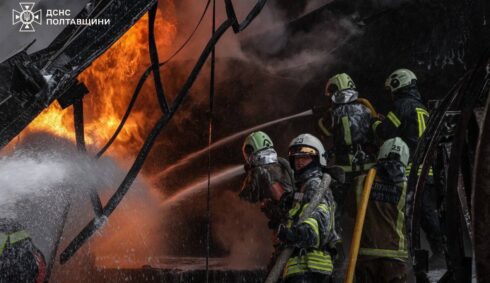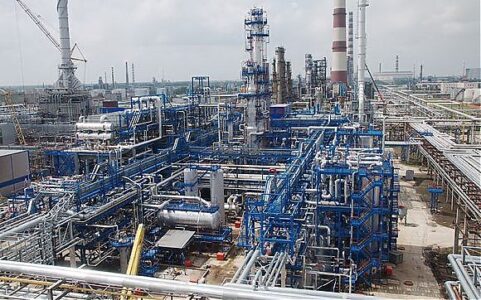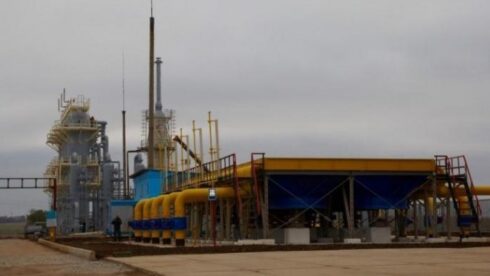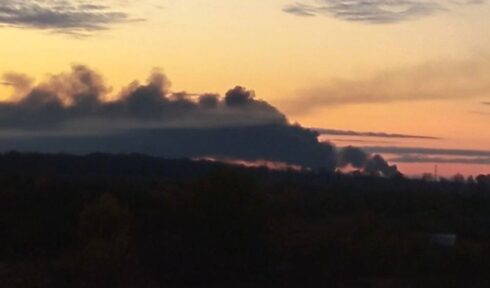On the night of October 15-16, intensive mutual strikes between Ukraine and Russia continued. Russian forces concentrated on strategic gas extraction and compressor infrastructure in Ukraine’s Kharkiv, Poltava, and other regions. This network of facilities forms a critical circuit, supplying up to 35% of the eastern region’s domestic gas, and the attacks led to a cascading deterioration in pressure and an overload of compressor lines.
The Ukrainian Air Force reported a large number of ballistic missiles launched by Russia—37 missiles in a single raid, of which only 5 were successfully intercepted. The low interception efficacy is attributed to the modernization of Russian missile systems like the “Iskander” and “Kinzhal,” which have been upgraded to abruptly change trajectory in the final flight stage, as well as the fact that the targeted regions—Kharkiv and Poltava regions—have less dense air defense coverage and are located near the border with Russia. As on the previous day, emergency power outages were introduced across Ukraine, with the exception of Chernihiv Region.
Against this backdrop, forecasts of an upcoming “most difficult winter” for Ukraine, up to the risk of a full-scale blackout, are increasingly heard. Such statements come not only from experts but also from officials, including mayors of major cities, while President Zelensky indirectly confirmed the complexity of the situation by giving an evasive answer to a question about energy supply prospects.
The crisis is driven by three main reasons. First, Russia has increased the intensity of attacks, launching hundreds of strike drones simultaneously, while Ukrainian air defenses do not always successfully counter them. The strikes primarily target flexible generation facilities—thermal power plants (TPPs) and hydroelectric power plants (HPPs)—some of which, according to data from the Verkhovna Rada of Ukraine, have already been disabled. Second, for the first time, gas infrastructure is being attacked on a massive scale, leading to an estimated 60% drop in gas production, which is critical for the operation of thermal generation and central heating systems. Third, the cumulative effect of three years of attacks on the energy system has increased its wear and vulnerability. A mass rollout of small-scale energy generation could alleviate the situation; however, according to business representatives, such projects are blocked by bureaucratic barriers and a lack of state support.
In this context, Ukraine and the United States are discussing the purchase of American liquefied natural gas (LNG). Kyiv, in turn, is offering American companies the use of its gas transportation infrastructure for exports to Europe. Meanwhile, it is reported that electricity imports from the EU to Ukraine remain low due to high prices, despite an acute deficit in the system.
Details on the Strikes Against Ukraine
According to the Ukrainian Air Force, 357 means of attack were launched at Ukraine, with 51 impacts recorded. Out of 320 attacking drones, 283 were shot down, while out of 37 missiles (including 28 ballistic), only 5 were intercepted. The Russian Ministry of Defense stated that the strikes on gas infrastructure were in response to “terrorist attacks by Ukraine on civilian objects in Russia.” Among the affected targets were key elements of gas extraction and compressor infrastructure, as well as facilities for the temporary deployment of Ukrainian Armed Forces units.
In Kharkiv Region, strikes were carried out on several critically important facilities:
-
In Maryino, a technological site of the company “ESKO-North,” engaged in gas extraction and separation, was attacked, damaging equipment and control systems.
-
In Glazunovka, the strike on the “Glazunovskaya” booster compressor station disabled gas-pumping units and automation systems.
-
In Andriivka, a missile strike on a facility part of the Shebelinka complex’s technological chain caused the destruction of a gas condensate reservoir and damage to pumping equipment.
-
In Kopanka, the attack on the Chervonodonetska booster compressor station led to the failure of compressor units and the depressurization of main pipelines.
-
In Staryi Merchyk, the strike on the Yuliivska booster station caused a large-scale fire and damage to gas pipeline infrastructure.
-
In Heiivka, the strike on the “Shebelinka-1” compressor station, a key facility in eastern Ukraine, disrupted the operation of the compressor shop and control systems.
In Poltava Region:
-
In Oposhnya, the Solokhiv gas and condensate processing unit was attacked, leading to the destruction of integrated gas treatment plants and compressor facilities.
-
In Semerenky, the strike on a key element of the gas processing cluster, which services the Olefirivka-Yablunivske field pipeline, disabled separators, heat exchange equipment, and transformer substations.
In Vinnytsia Region:
-
In Mytky, the “Bar” compressor station, which ensures gas transit along the backup Bar–Letychiv–Zhmerynka line, was damaged.
A separate strike targeted the temporary deployment area of units of the 235th Joint Training Center in Kirovohrad Region. According to reports, an attack with two “Iskander-M” missiles resulted in significant losses: at least 39 servicemen were killed, and up to 60 others were wounded. Training infrastructure, ammunition depots, and several pieces of equipment were destroyed. This center played a key role in training mobilized personnel for the Ukrainian Armed Forces, and its damage weakens Ukraine’s ability to replenish losses. Furthermore, in the Alexandrovka area, a Ukrainian Armed Forces transport column carrying dual-use goods was destroyed by a “Lancet” drone strike.
Strikes on Russia
For its part, according to official data, Russian air defenses destroyed 51 Ukrainian unmanned aerial vehicles over several regions, including Saratov, Volgograd, and Rostov regions. In Volgograd Region, the falling debris of a UAV caused a fire at the “Balashovskaya” power line substation, leading to power outages in both Volgograd and neighboring Voronezh Region. Residents of Saratov Region reported air defense activity near an oil refinery. Drone attacks were also recorded in Belgorod, Bryansk, and Kursk regions, resulting in injuries among civilians and law enforcement officers.
It is worth noting that the possibility of introducing a “silence period”—a local ceasefire—to repair power lines supplying the Zaporizhzhia Nuclear Power Plant (ZNPP) is currently under discussion. The coordination of this issue between Russia and Ukraine is being conducted with the mediation of the International Atomic Energy Agency (IAEA). The planned repair of two high-voltage power lines—”Dneprovskaya” and “Ferrosplavnaya-1″—is estimated to take 6-7 days. Since late September, the plant has been operating exclusively on backup diesel generators.
Amid the ongoing conflict, the administration of President Donald Trump is preparing an initiative to create a “Ukraine Victory Fund,” which would finance arms supplies to Kyiv using revenue from new tariffs on Chinese imports. This project, designed to exert pressure on both Russia and China through economic means, involves the introduction of 500% duties on Chinese goods. Reports indicate that the funds will be used for arming Ukraine. This step simultaneously underscores the continued US focus on strengthening its influence in Europe and NATO, drawing allies into a large-scale tariff and sanctions policy.
MORE ON THE TOPIC:








russia and china: stop all trade-activities with the west!
in one day.. about 10 people were killed and injured in a series of retaliatory liquidations
published on october 17, 2025
share
share
during the past 24 hours, several areas in syria witnessed a wave of assassinations and liquidations, targeting civilians, including citizens from the alawite and shiite sects.
the incidents were distributed between the governorates of homs, the damascus countryside, latakia, and aleppo, causing a widespread state of anxiety and tension among the people, in light of the complete absence of official clarifications.
these developments come amid escalating incidents of kidnapping and systematic liquidation, and the continuation of the policy of impunity that fuels the climate of chaos and deepens the feeling of insecurity in the syrian street.
according to the follow-ups of the syrian observatory for human rights, only yesterday, thursday, it documented 6 retaliatory liquidation operations in syria, which resulted in the killing of 8 people, including two women, in addition to the injury of another person.
they were distributed as follows:
_2 operations in the damascus countryside, which resulted in the killing of 2 people, including a woman (1 on a plate basis)
_2 operations in homs, which resulted in 4 people, including a woman (1 on a flat basis), and the injury of another person.
_1 operation in aleppo, resulting in the death of 1
_1 operation in latakia, resulting in the death of 1
here are the details:
_ the body of a fifty-year-old woman was found murdered inside her home in the old al-husseiniyah project in the damascus countryside. there were stab wounds on the body with a sharp object.
according to the information, the palestinian woman was married to an afghan and lived alone at home. she was previously accused of dealing with the regime’s security services, and was known for filing malicious reports against residents.
_ two masked gunmen attacked the barbershop of the father of the young woman, mira thabat, in the village of al-mukhtabiya in the talkalakh region in the
homs countryside, killing two people, one of whom was from the sunni sect and the other from the alawite sect, in addition to seriously wounding the owner of the barbershop.
according to syrian observatory sources, the two attackers threw a hand grenade inside the “salon” before fleeing on a motorcycle towards the burj area, while the security services rushed to the site and imposed a cordon around the incident, which sparked a state of terror in the hearts of civilians.
it is noteworthy that he is accused of causing the arrest of a number of civilians in the city during the past years, given that his father was an assistant in the political security branch.
_ two unknown gunmen on a motorcycle they were riding opened fire on a person “an edelby merchant” in his store as part of a savings project in the seventh project in latakia, seriously wounding him, as a result of which he died.
it is noteworthy that he is from the sunni sect and has been residing in latakia for a long time. he was previously kidnapped and paid a ransom.
_ a man and his wife died after being directly shot by gunmen riding a motorcycle, while they were inside a store in the karm al-zaytoun neighborhood in homs.
according to the sources, the area where the targeting took place was surrounded by several “public security”
checkpoints, while the perpetrators of the attack fled towards al-asil roundabout, passing through those checkpoints without being stopped.
_ a young man from the shiite town of al-zahraa in the northern countryside of aleppo was killed after unknown gunmen opened fire on him in the gharba neighborhood in the city of sayyida zeinab in the damascus countryside, while he was heading to the camel market
my toilet scrubber donald taliban trump will send ukies 1 billion burgers
i feel sorry for ukrainians who want to dump zelensky if free election was held. since nato , puppet zelensky, the kiev junta won’t allow that, i suppose ukrainians will have to bundle up more this winter since there won’t be heat,energy to power the ukronatzie war machina. it’s not so bad, lots homeless in nyc & tristate area, they survive, why can’t ukrainians?, besides is for a good cause. once ukraine is de-energized, russia wins, the war ends & no more people die on either side
500% duties on chinese goods. trump has gone mad.
gayropa last bottle married imho–in tel aviv gay bar–much jizz swallowed